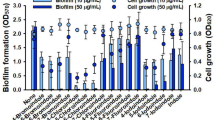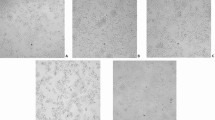Abstract
The growth-inhibitory effects of anthracene were determined against intestinal bacteria, and compared with those of its derivatives for a better understanding of structure-activity relationships. The Growth inhibiting activity was shown to vary the chemical, dose, and bacterial strain tested. In tests with Clostridium perfringens, anthracence evidenced strong (+++) and moderate (++) growth inhibition at 1.0 and 0.25 mg/disc, respectively, but exhibited no growth inhibition effects against lactic-acid producing bacteria and E. coli. In our study of structure-activity relationships, anthracene-9-carboxylic acid evidenced strong (+++) and moderate (++) growth inhibition at 1.0 and 0.25 mg/disc, respectively, but anthracence-9-carboxaldehyde, anthrone, and 9-(hydroxymethyl)-anthracene exhibited no growth-inhibitory effects against six intestinal bacteria. In conclusion, the growth-inhibitory activities of anthracene and anthracene-9-carboxylic acid against C. perfringens may be indicative of at least one of these pharmacological actions. Furthermore, anthracene and anthracene-9-carboxylic acid may prove useful as prospective therapeutics for the treatment of gastrointestinal diseases caused by C. perfringens.
Similar content being viewed by others
Abbreviations
- BHI:
-
brain heart infusion
- EG:
-
eggerth-gagnon
- MRS:
-
deMan rogosa sharpe
References
Boonmar S, Bangtrakulnonth A, Pornruangwong S, Samosor S, Kaneko K, and Ogawa W (1998) Significant increase in antibiotic resistance of Salmonella isolates from human beings and chicken meat in Thailand. Vet Microbiol 62, 73–80.
Demirci F, Guven K, Demirci B, Dadandi MY, and Base KHC (2008) Antibacterial activity of two Phlomis essential oils against food pathogens. Food Control 19, 1159–1164.
Fuller R (1989) Probiotics in man and animals. J Appl Bacteriol 66, 365–378.
Granum PE (1990) Clostridium perfringens toxins involved in food poisoning. Int J. Food Microbiol 10, 101–112.
Harris RC (1988) Review of selected bacterial enterotoxins and their role in gastroenteritis. Ann Clin Lab Sci 18, 102–108.
Hentges DJ (1983) Role of the intestinal microflora in host defense against infection. In Human intestinal microflora in health and disease, Hentges DJ (ed.), pp. 311–331. Academic Press, NY, U.S.A.
Isolauri E, Kaila M, Arvola T, Majamaa H, Rantala I, Virtanen E, and Arvilomml H (1993) Diet during rotavirus enteritis affects jejunal permeability to macromoleules in sucking rats. Pediatr Res 33, 548–553.
Jeon JH, Lee CH, and Lee HS (2009a) Antimicrobial activities of 2-methyl-8-hydroxyquinoline and its derivatives against human intestinal bacteria. J Korean Soc Appl Biol Chem 52, 202–205.
Jeon JH, Song HY, Kim MG, and Lee HS (2009b) Anticoagulant properties of alizarin and its derivatives derived from the seed extract of Cassia obtusifolia. J Korean Soc Appl Biol Chem 52, 163–167.
Kim HG, Cho JH, Jeong EY, Lim JH, Lee SH, and Lee HS (2006a) Growth inhibiting activity of active component isolated from Terminalia chebula fruits against intestinal bacteria. J Food Prot 69, 2205–2209.
Kim YM, Jeong EY, Lim JH, and Lee HS (2006b) Antimicrobial effects of 8-quinolinol. Food Sci Biotechnol 15, 817–819.
Lee HS and Ahn YJ (1998) Growth inhibiting effects of Cinnamomum cassia bark-derived materials on human intestinal bacteria. J Agric Food Chem 46, 8–12.
Lim MY, Jeon JH, Jeong EY, Lee CH, and Lee HS. (2007) Antimicrobial activity of 5-hydroxy-1,4-naphthoquinone isolated from Caesalpinia sappan toward intestinal bacteria. Food Chem 100, 1254–1258.
Sadeghi-Aliabadi H, Tabarzadi M, and Zarghi A (2004) Synthesis and cytotoxic evaluation of two novel anthraquinone derivatives. Farmaco 59, 654–659.
Wilcox MH (2000) Infective antibiotic-associated diarrhea. In Infection highlights 1999–2000, Wilcox MH (ed.), pp. 57–64. Health Press, Oxford, UK.
Wuriz TP, Craven MT, Karol MD, Hill GC, and Remers WA (1990) DNA binding by antitumor anthracene derivatives. J Med Chem 33, 1549–1553.
Xie SQ, Zhang ZQ, Hu GQ, Xu M, and Ji BS (2008) HL-37, a novel anthracene derivative, induces Ca2+-mediated apoptosis in human breast cancer cells. Toxicology 254, 68–74.
Author information
Authors and Affiliations
Corresponding author
Rights and permissions
About this article
Cite this article
Kim, MG., Jeong, EY. & Lee, HS. Antimicrobial effects of anthracene and its derivatives against intestinal bacteria. J. Korean Soc. Appl. Biol. Chem. 52, 327–330 (2009). https://doi.org/10.3839/jksabc.2009.058
Received:
Accepted:
Issue Date:
DOI: https://doi.org/10.3839/jksabc.2009.058




